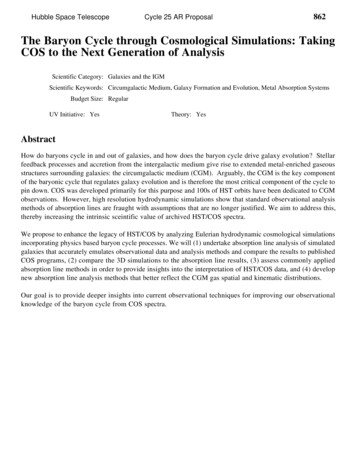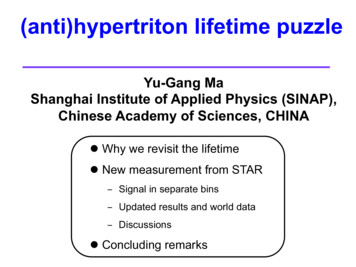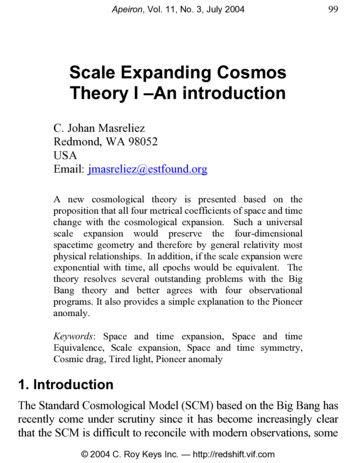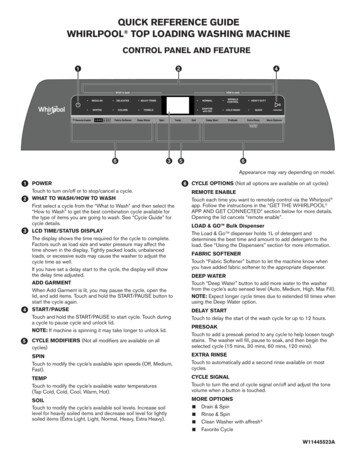
Transcription
Hubble Space TelescopeCycle 25 AR Proposal862The Baryon Cycle through Cosmological Simulations: TakingCOS to the Next Generation of AnalysisScientific Category: Galaxies and the IGMScientific Keywords: Circumgalactic Medium, Galaxy Formation and Evolution, Metal Absorption SystemsBudget Size: RegularUV Initiative: YesTheory: YesAbstractHow do baryons cycle in and out of galaxies, and how does the baryon cycle drive galaxy evolution? Stellarfeedback processes and accretion from the intergalactic medium give rise to extended metal-enriched gaseousstructures surrounding galaxies: the circumgalactic medium (CGM). Arguably, the CGM is the key componentof the baryonic cycle that regulates galaxy evolution and is therefore the most critical component of the cycle topin down. COS was developed primarily for this purpose and 100s of HST orbits have been dedicated to CGMobservations. However, high resolution hydrodynamic simulations show that standard observational analysismethods of absorption lines are fraught with assumptions that are no longer justified. We aim to address this,thereby increasing the intrinsic sceintific value of archived HST/COS spectra.We propose to enhance the legacy of HST/COS by analyzing Eulerian hydrodynamic cosmological simulationsincorporating physics based baryon cycle processes. We will (1) undertake absorption line analysis of simulatedgalaxies that accurately emulates observational data and analysis methods and compare the results to publishedCOS programs, (2) compare the 3D simulations to the absorption line results, (3) assess commonly appliedabsorption line methods in order to provide insights into the interpretation of HST/COS data, and (4) developnew absorption line analysis methods that better reflect the CGM gas spatial and kinematic distributions.Our goal is to provide deeper insights into current observational techniques for improving our observationalknowledge of the baryon cycle from COS spectra.
The Baryon Cycle through Cosmological Simulations: Taking COS to the Next Generation ntryC ChurchillNew Mexico State UniversityUSA/NMG KacprzakSwinburne University of TechnologyAUSA KlypinNew Mexico State UniversityUSA/NMN NielsenSwinburne University of TechnologyAUSNew Mexico State UniversityUSA/NMJ Vander VlietNumber of investigators: 5Dataset Summary:
Scientific JustificationThe last decadal report (2011, National Research Council) singled out the following questionsas top priority for extragalactic science: “How do baryons cycle in and out of galaxies,what do they do while they are there, and how does the cycle drive galaxyevolution?” Elevating the “baryon cycle” to top priority comes with the realization thatthe cycling of baryons through dark matter halos is a dominant process responsible for theobserved universe of stars and galaxies. Knowing the baryon cycle means a fundamentalunderstanding of galaxies, star formation, and chemical evolution.The interplay between stellar feedback processes in the interstellar medium (ISM) andfilamentary accretion from the intergalactic medium (IGM) gives rise to extended ( 150kpc) metal-enriched gaseous structures surrounding galaxies, i.e., the circumgalactic medium(CGM). As the interface between the ISM and IGM, the CGM is a key regulating componentof galaxies and therefore a critical component of the baryon cycle to understand.From a theoretical standpoint, the key is to establish the physical processes by whichbaryonic matter responds to the full spectrum of gravity induced dark matter overdensities,thereby explaining many observed global galaxy relations (such as the stellar mass to halomass ratio and its cosmic evolution, and the stellar mass metallicity relation; Tremonti 2004, ApJ, 613, 898; Andrews 2013, ApJ, 765, 140; Behroozi 2013, ApJ, 770, 57, Gu 2016, ApJ, 833, 2; Ly 2016, ApJ, 828, 67). Significant effort has been directed towardunderstanding the baryon cycle using hydrodynamic cosmological simulations via the tracking of gas cycles and the modeling of star formation and feedback physics (Kereš 2005,MNRAS, 363, 2; Oppenheimer 2008, MNRAS, 387, 577; Ceverino 2009, ApJ, 695, 292;Kereš 2009, MNRAS, 395, 160; Ceverino 2013, MNRAS, 442, 1545; Trujillo-Gomez 2015, MNRAS, 446, 1140; Christensen 2016, ApJ, 824, 57; Davé 2016, MNRAS, 426,3265; Finlator 2016, arXiv:1612.00802). Davé et al. (2011a, MNRAS, 415, 11) were able toshow that star-forming galaxies develop via a slowly evolving equilibrium balanced by inflows(driven by gravity/mass), wind recycling, star formation rates, and outflows, the latter regulating the fraction of inflow that gets converted into stars. The CGM gas content regulatesthe competition between IGM inflow and gas consumption within the ISM as governed bystar formation (Birrer 2014, ApJ, 793, 12).The best approach for observationally probing baryons in, around, and between galaxiesis to analyze absorption lines in spectra of background sources (quasars) with sightlinespassing near galaxies. The Cosmic Origins Spectrograph (COS) on HST was developedprimarily for this purpose. From the observational standpoint, the key is to quantify andcharacterize the dynamics, spatial distributions, metallicities, densities, and temperatures ofthe gas flowing into, out of, and through galaxies. Absorption lines indirectly provide theseproperties; we say “indirectly” because chemical-ionization models of the gas are requiredto take incomplete information from various absorbing transitions of various ions in order toconstruct a complete visualization of the gas. A further difficulty is that the lines-of-sightto the luminous sources provide a pencil beam 1D probe of the gas as a function of line ofsight velocity (3D velocity dotted into the line of sight). We are quite blind to reality.1
UV Initiative and HST/COS/STIS Legacy: Even with these well-known hurdles,large investments in HST time have been dedicated to absorption line observations of theCGM, such as COS-Halos (11598, 13033), COS-Dwarfs (12248), the COS Science Team(11541, 12025), our Large Program (12466, 12252, 13398), and others (e.g., 10151). Thesesurveys, representing 650 HST orbits, effectively provide the world’s entire library of UVspectroscopic data on the CGM associated with identified galaxies ( 200 galaxies). Theyare the collective UV legacy of HST/COS and STIS ultraviolet absorption line data that willremain available for study well beyond the lifetime of HST. Our goals are to examine and“calibrate” current analysis methods of COS/STIS spectra using simulated data to gain deeperinsight into the baryon cycle and spearhead the long-term collective process of increasing thevalue of archived HST UV absorption line spectra.The key to deeper insights into HST/COS STIS absorption line data are to emulate observational survey parameters and analysis techniques employed by the observers to “mock”data from the cosmological simulations. Astonishingly, nobody is adopting this approach,which offers our only direct quantitative method for connecting the 1D probes provided byHST/COS STIS to the 3D gas spatial distribution and velocity fields in simulations. Historical precedent for dramatic success of absorption line analysis throughsimulations is the revolution in understanding of the Lyα forest in the 1990s, which yieldedthe cosmic web paradigm of large scale structure. Armed with high-resolution absorptionline data of the Lyα forest, our models of the Hi gas were no more sophisticated than“spheres”, “slabs”, and “dark matter mini-halos” (Meylan 1995, “QSO Absorption Lines”,Springer-Verlag). The data alone had no potential to uncover the large scale coherent structure of H i in the IGM. Simulations forced a paradigm shift. Currently, models of the CGMused to explain data are in their infancy; outflows are modeled as “bi-conical winds”, accretion as planer inflows due to angular momentum loss, and incidence statistics by spherical“halo” distributions and halo occupation formalism (e.g., Tinker & Chen 2010, ApJ, 709, 1;Bouché 2013, Science, 341, 50; Bordoloi 2014 ApJ, 784, 108; Fox 2015, ApJ, 799, 7).The CGM gas itself is naively modeled as discrete isothermal “clouds” using Voigt profiles.Modern cosmological simulations incorporate sophisticated stellar feedback processesinto the baryon physics (supernovae, radiation pressure, radiative heating, etc.) These provide an open road for applying observational absorption line analysis methods to simulatedgalaxies. The coming change in the methods of analysis holds the potential for revolutionaryparadigm shift in our interpretation of HST/COS STIS absorption line data.We propose to maximize the legacy of HST/COS by exploiting cutting-edgeEulerian adaptive mesh refinement hydrodynamic cosmological simulations incorporating physics based baryon cycle processes. We will (1) undertake absorption line analysis of simulated galaxies that accurately emulates observational data and analysis methods, (2) compare the 3D simulations to the 1Dabsorption line results, (3) quantitatively calibrate current methods in order toprovide heightened insights into the interpretation of HST/COS data, and (4)work toward developing new absorption line analysis methods.2
Our methods are founded on generating realistic spectra (pixel scales, resolution sampling, noise characteristics) and emulating the impact parameter, galaxy mass, redshift, andspectral detection sensitivity distributions of the observational surveys. Totally unique toour approach is that we have developed a method to isolate the actual gas cells in the simulations that created the absorption lines (Churchill 2015a, ApJ, 802, 10; Vander Vliet 2017,NMSU PhD). This is critically important because it means we can select the gas in thesimulations that is being probed by the observations conducted by the HST/COS surveys,rather than generically comparing to the simulations.In Figure 1 , we see a simulated galaxy and CGM (Churchill 2015a) having suchcomplexity that current observational analysis are rendered obsolete. For the shown line ofsight (LOS), “mock” Hi Lyβ, Mgii λ2796, Civ λ1548, and Ovi λ1031 absorption lines arepresented. The data are FUV and NUV COS spectra and, for Mgii, HIRES spectra. TheLOS spatial locations, densities, temperatures, and metallicities of the gas cells responsiblefor the absorption (the “absorbing gas”) are indicated with color coded “ ” data points.We find that Hi and Mgii absorption arise in “cloud-like” structures that are confined tocontiguous gas cells over small spatial scales and have a narrow temperature distribution,but with density and metallicity gradients. However, we find that the Civ and the Oviabsorption is not cloud-like; the absorption arises from gas spatially distributed over 100kpc with a complex reversing velocity flow that results in multiple separated locations givingrise to absorption at a single value of LOS velocity. (Dear reader, apologies for the figure’scomplexity- but so is the CGM!). Furthermore, note that the Ovi absorption arises fromgas without detectable Hi absorption. How do we analyze that?These insights run completely counter to currently applied analysis methods(Voigt profile modeling and chemical ionization modeling), which assume (1)discrete clouds with single valued densities, temperatures, and metallicities, and(2) discrete clouds at each LOS velocity. It follows that systematic errors will bethe outcome of our current analysis methods. Determining these systematics is one of ourgoals (see Analysis Plans for all goals). To what degree do the gas properties we derivefrom commonly employed observational analysis techniques applied to absorption lines fromsimulations match the properties of the gas actually giving rise to the absorption? Whatsignatures can be identified in the absorption line data that clearly indicate the complexvelocity fields and spatially discrete structures that map to a given LOS velocity (such as weillustrated for Ovi in Figure 1)? What are plausible new approaches to absorptionline analysis that incorporate this more realistic view of the CGM? What are theimplications for our understanding of the CGM and the baryon cycle once the signaturescan be employed for observational data systematics are accounted?Analysis of absorption properties in hydrodynamic cosmological simulation is a highlypromising, yet undeveloped methodology with regards to the baryon cycle. We aim todevelop novel analysis methods using simulations so that deeper insights can be gleanedfrom absorption line data, especially HST/COS STIS spectra. Beyond HST, the COS STISarchives can continue to deliver new insights into understanding galaxy evolution as analysismethods evolve; comparison to simulations will be key to the HST legacy.3
0 H 3MgCO 5log nH 2 4 6SLO 50 25 0 25 S, kpc50 50 25 0 25 S, kpc50 50 25 0 25 S, kpc50 50 25 0 25 S, kpc50density n(H) 2Temperature, K 4log n(H) 6log T4.5SLO4 1.5 2Metallicity, Z 2.5Log Z 350SLO25 S, kpc0 25 50MgII λ2796HI LyβCIV λ1548OVI λ10311 S, kpc is distance along theLOS relative to galaxy center.It is measured from lower leftto upper right in the aboveimages of the simulated galaxy.50 100 50050 100 40 20 0v, km/s20 40 60 40 20 0v, km/s20 40 60v, km/s 20 020 40 60 80v, km/sFigure 1: Unique to our study is that we focus on the gas cells that contribute to absorptionand can therefore examine the physical properties of the “absorbing gas” for direct comparison ofdeduced properties from observational analysis methods applied to the simulated spectra. Thisaspect of our study provides unprecedented insight into the accuracy of methodsapplied to HST COS and STIS spectra of the CGM. — (left panels) The density,temperature, and metallicity images of the simulated galaxy, showing a “mock” line of sight(LOS). — (top right) the density of the gas as a function of LOS position, where S 0 is theplane of the sky from the observer point of view. Absorbing gas cells are highlighted in red (Hi),purple (Mgii), green (Civ), and blue (Oiv). — (bottom right panels, top to bottom) The density,temperature, metallicity, and LOS position of absorbing gas cells, and the absorption profiles as afunction of LOS velocity, v. Note that Hi and Mgii absorbers are “cloud-like”, with a tight rangeof properties, but that Civ and Ovi absorbers comprise multiple spatially separated structures atany given LOS velocity (consider v 5–15 km s 1 as denoted by the vertical dashed lines.Conclusion: standard VP analysis of C iv and O vi is a failed analysis method.4
Analysis PlanOur overall science goals for studying the baryon cycle are summarized by the following:(1) to examine how the absorbing gas properties of the CGM depend on different feedbackmodels for different mass galaxies; (2) to examine how galaxies of different masses accretegas from the IGM, and how different feedback models modify the accretion and transportof accreting gas through the CGM; (3) to investigate the mechanisms by which baryonsare transported, mixed, and cycled back into the CGM following stellar feedback processes;(4) to determine the degree to which the gas properties derived from commonly employedobservational analysis techniques, as applied to absorption lines from simulations, match theproperties of the absorbing gas. Foremost of these goals are the objectives to understandthe baryon cycle and its role in galaxy evolution while to provide improved insights into theanalysis of COS spectra of the CGM. The Simulations and “Mock” Absorption LinesWe employ the adaptive mesh refinement N-body and hydrodynamics code hydroART(Kravtsov 1997, ApJS, 111, 73; Kravtsov & Klypin 1999, ApJ, 520, 437) as modifiedwith cutting-edge stellar feedback physics (Ceverino & Klypin 2009, ApJ, 695, 292; TrujilloGomez 2015, MNRAS, 446, 114). Galaxies are formed and evolved in the full cosmologicalenvironment. Physical processes implemented in the code include star formation, stellarfeedback, Type II and Ia metal enrichment, thermal and radiation pressure, photo-heating,and metallicity-dependent cooling and heating. Gas is self-shielded, advects metals, is heatedby a homogeneous ultraviolet background, and can cool to 100 K due to metal and molecularline cooling. Gas flows, shock fronts, and metal disbursement follow self-consistently fromthis physics. Star formation occurs in the dense, cold molecular phase (nH 100 cm 3 ,T 100 K), which is disrupted by the combination of radiation pressure and photoionization by massive stars. The resolution ranges from 20–200 pc, depending on redshift andhalo mass. We developed a full-treatment photo collisional ionization code (fully testedagainst Ferland’s Cloudy, Churchill 2015b, arXiv:1409.0916) that computes the ionizationcorrections for all ionic species in each cell of the simulation box. The treatment accountsfor shielding by neighboring cells and for both UVB and stellar radiation (using Starburt99SEDs accounting for the ages, metallicities, and distances of stellar particles).We have built a library of 17 Milky Way mass galaxies run to z 1, 40 dwarf galaxiesrun to z 0, 80 sub-Milky Way mass galaxies to z 0, and are currently running 60 dwarfand super-Milky Way mass galaxies to z 0. We incorporate three components to the stellarfeedback models: (1) supernovae and stellar winds, SNW; (2) radiation pressure, RP; (3)weak or strong photoheating, PH1/PH2. All galaxies include SNW, whereas variations of RP,and PH1 or PH2 are employed. Two star formation models are examined: (1) probabilistic,where 100% of the gas meeting the threshold for star formation is converted to stars basedupon a fixed probability, and (2) deterministic, where 2% of the gas is converted to starsevery time the gas meets the threshold for star formation. We thus, in the course of ourstudy, will examine how the CGM and the absorption lines it gives rise to depend on variousbaryon cycle physics (i.e., feedback recipes).5
Analysis of “Mock Absorption Lines”We have fully developed and tested a science-ready pipeline to (1) generate LOS vectors,(2) run the LOS through the simulations, (3) generate realistic simulated spectra with fullyspecified data characteristics, (4) automatically and objectively detect and quantitativelymeasure the absorption lines, (5) determine the gas cells in the simulations that give riseto the detected absorption lines for each ion for each LOS, and (6) catalog the results forscience analysis. Details are presented in Churchill et al. (2015a). Typically, we run 1000LOS through the simulated galaxies for two to four galaxy orientations. The LOS range from0 D/Rvir 2.0. For comparison with observations, the synthetic spectra are generatedusing the exact characteristics of observed data, including the resolution (convolution withthe instrumental spread function), pixelization, and noise characteristics. Using HST UV Spectra to Constrain Baryon Cycle PhysicsIn Figure 2 , we present selected observations of the CGM (Nielsen 2013, ApJ, 776,115; Churchill 2013, ApJ, 763, L42; Nielsen 2016, ApJ, 818, 171). These Mgii distributions serve to illustrate a small sample of observed characteristics of the CGM that canbe examined. For Hi, Civ, and Ovi absorption, there exists a substantial body of similarobservational work that can be exploited for direct comparison of “mock” absorption linesfrom the simulations having different baryon cycle physics (e.g., Fox 2013, ApJ, 778, 187;Stocke 2013, ApJ, 763, 149; Bordoloi 2014, ApJ, 796, 136; Werk 2014, ApJ, 792, 8; –2016, ApJ, 833, 54; Kacprzak 2015, ApJ, 815, 22; Borthakur 2015, ApJ, 813, 46; – 2016,ApJ, 833, 259; Burchett 2016, ApJ, 832, 124; Keeney 2017, arXiv:1704:00235; Nielsen 2017, ApJ, 834, 148; Prochaska 2017, ApJ, 837, 169)10110110 110 2M log Mh /M 010 1M 11.711.7 M 12.010 2M 12.0 3102101D (kpc)12.0 M 12.3M 12.3M 12.010fc (D/Rvir 0.50)10Wr (2796) (Å)Wr (2796) (Å)101.0(b)0100.5(c)0.8(d)0.4P( vcloud )(a)0.60.40.2Wcut 0.3 ÅM 12.00.3M 12.00.22.4σ0.10.0 310010 110D/Rvir111213log Mh /M 140.001234 vcloud , km s 15Figure 2: Model Independent Testing of Baryon Cycle Physics – (a) Mgii rest-frameequivalent width, Wr (2796) vs impact parameter; higher mass halos have stronger absorptionstrengths in fixed impact parameter ranges. (b) Wr (2796) versus D/Rvir , where Rvir is the virialradius, showing Wr (2796) (D/Rvir ) 2 . (c) The covering fraction within D/Rvir 0.5 forWr (2796) 0.3 Å vs halo mass; covering fraction is independent of halo mass. The blue dottedline represents the theoretical prediction of cold-accretion. (d) The CGM velocity dispersionrelative to the central galaxy (units of circular velocity) for low- and high-mass halos. Similardata for Hi, Civ, and Ovi absorption is abundant from studies of COS and STIS spectra. Examining Model Dependent Absorption Line Analysis: New ApproachesIn addition to comparing the cause and effect response of the CGM to various baryoncycle physics in the simulations, we will focus on the comparison between the gas properties (density, temperature, ionization condition, metallicity, and kinematics) inferred from6
standard analysis techniques (Voigt profile, VP, fitting, chemical-ionization modeling) applied to “mock” absorption lines and the true underlying distributions of the gas propertiesresponsible for the absorption in the CGM of the simulated galaxies.Consider the following scenario: Some CGM absorption lines are observed in somespectra. VP fitting yields a set of column densities for various ions (kinematically complexabsorption lines are modeled as multiple clouds with fixed column densities and isothermaltemperatures). Photoionization models are run, constrained by the column densities, andmetallicities are derived. Ultimately, gas properties are deduced that, for each VP component(cloud) a single metallicity, density, and perhaps an inferred abundance variation is quotedat each component velocity. This is what is published and employed for our understandingof the spatial distribution of the CGM as a function of galaxy property, projected distance,and redshift.Now, simulate the above process with the absorption lines from the CGM of simulated galaxies in hydroART. Perform the above analysis just as an observer would and deducethe absorbing gas properties. Now, select out the gas cells from the simulation that giverise to the detected absorption lines (we have this capability), and examine the distributionof the “absorbing gas” metallicities, densities, temperatures, positions, and LOS velocities.How do they compare? Are there systematic offsets in the value (under- or over-estimates).Are the gas cells even physically contiguous (is the absorbing gas at a given velocity evencome from the same physical location along the LOS)?If Figure 1 is any indication of the nature of the true CGM, ions such as Civ and Oviare not “cloud-like” and thus the above described observational analysis methods wouldbe failing at accurately describing the CGM. This is an example of an important resultwith far-reaching implications, but for which we may (or may not) be “fooled” by possiblesystematics lurking in our analysis methods. How can analysis be modified to better recoverthe underlying distributions and gradients of gas phase properties? How would doing sochange our view of baryon cycle mixing in the CGM?A more sophisticated modeling of absorption lines arising in gas with varying densities, velocity flows, and temperatures requires line formation with frequency redistribution,such as is employed for modeling expanding stellar winds. Examples of the mathematicalformalism for such modeling is presented in Chapters 13 and 14 of Mihalas (1978, “StellarAtmospheres”, Freeman) and in Chapter 7 of Mihalas & Mihalas (1999, “Foundations ofRadiation Hydrodynamics”, Dover). We aim to adopt the formalism of Mihalas and applyit to absorption line formation in cosmological simulations as a way to extract more realisticinsights into the density, velocity (flow and turbulence), temperature, and metallicity distributions of CGM gas, especially their LOS gradients. We have been exploring these methodsfor the last few years and are poised to demonstrate that they can be successfully applied toabsorption line data such as COS and STIS spectra. The use of “mock” spectra through thesimulation will be key for testing and calibrating the method. Preliminary studies indicatethat transitions from multiple ions of a chemical species will be important. This is especiallytrue for Hi; the full Lyman series will be critical for estimating the metallicity distribution.Fortunately, each of the COS surveys includes spectra that have captured the full series.7
Management PlanAll investigators will co-manage various components of the project and engage in interpretingresults and writing papers. In alphabetical order:Churchill will lead efforts to perform current Voigt profile fitting and chemical-ionizationmodeling methods with the goal of developing methods that more accurately recover the distribution of gas properties in the simulations from absorption line data.Kacprzak is an expert on the absorption line galaxy connection and will engage inanalyzing and comparing the observed and “mock” absorption line data to the results fromHST programs. He will also lead efforts to quantify how the CGM varies as a function ofbaryon physics in the simulations.Klypin is a primary architect of the hydroART code and an expert on feedback physics.He will be lead theorist, engaged in high-level interpretation of results and writing papers.He is a primary coder and will be responsible for running and managing the simulations (atNASA/Ames, NERSC, and SwinStar) and performing quality checks.Nielsen will engage in analysis of the “mock” absorption line data, investigating thespatial-kinematic relationship within the absorption profiles and assisting with developinginsights into current standard absorption line analysis methods.Vander Vliet will run the absorption line pipeline and generate all “mock” spectra. Hewill engage in comparing simulated absorption line properties to both published observationaldata and the simulated gas properties. He is and expert at analyzing the simulations and willengage in quantifying the star formation rates and masses of the galaxies. He will analyze thebaryon cycle for the various star formation and feedback models necessary for comparisonwith the CGM properties. Two-Year Time-lineWe emphasize that we have all of the analysis software to generate the absorption linedata from the simulations, extract the “absorbing gas” cells, and cull all these data into aconvenient science ready format. We also have the analysis tools to perform the VP fittingand ionization modeling.In Year 1, we will run the absorption line pipeline on galaxies of various masses andbaryon cycle physics, generate absorption quantities, and measure simulated galaxy properties. All analysis will carefully reproduce realizations of HST survey characteristics (distribution of impact parameters, galaxy masses, star formation rates, redshifts, absorbing transitions/ions, spectral characteristics, detection sensitivities, etc.). In Year 2, we will comparethe feedback recipes, engage in analysis of the baryon cycle physics and CGM properties,compare simulated “absorbing gas” properties to those inferred from VP fitting, and engagein exploring absorption line analysis methods that are not reliant on “cloud-based” assumptions to glean more accurate estimates of the distribution of CGM gas properties from HSTspectra.We anticipate three to four publications and that we will present our work at a minimumof two domestic and/or international conferences per year. The student and post-doc teammembers will be engaged in these conferences.8
COS programs, (2) compare the 3D simulations to the absorption line results, (3) assess commonly applied absorption line methods in order to provide insights into the interpretation of HST/COS data, and (4) develop new absorption line analysis methods that better reflect the CGM gas spatial and kinematic distributions.










